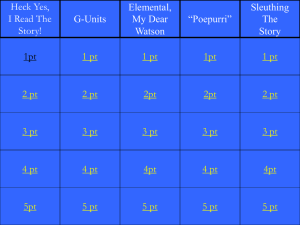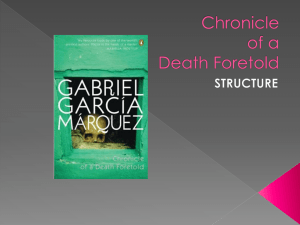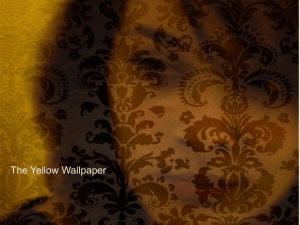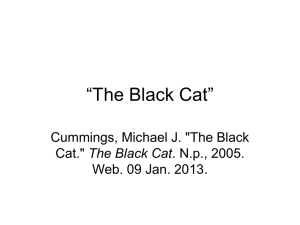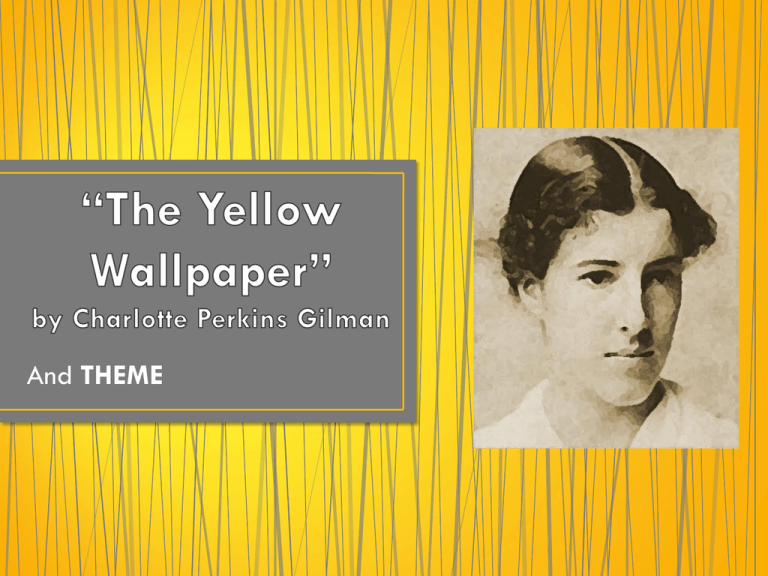
And THEME
1. The story is presented as
a. John's case study.
b. the narrator's journal.
c. a story told by the town gossip.
d. a series of letters between the narrator and an absent friend.
2. The room where the narrator is confined contains all of the following except
a. a large bed, nailed to the floor.
b. a hard chair, with straps to hold down the sitter's arms.
c. rings nailed into the wall.
d. bars on the window.
3. The narrator comes to believe that the wallpaper contains a "subpattern." What image does she see in the subpattern?
a. a woman
b. a physician
c. a mad dog
d. a dollar sign
4. Which of the following best describes John's attitude toward his wife?
a. He is very demanding, expecting her to run the house and care for the children with little time for herself.
b. He is easily angered and often snaps at her.
c. He is condescending and treats her as though she were a child.
d. He treats her as an equal.
5. What holiday does the family celebrate while they are staying in the house?
a. the Fourth of July
b. Labor Day
c. Thanksgiving
d. Valentine's Day
6. What is the narrator’s name?
a. Jennie
b. Jane
c. Jessica
d. we don’t know
7. How does the story end?
a. John faints.
b. The narrator jumps out the window.
c. John slaps the narrator.
d. The narrator wraps the torn wallpaper strips around her body.
1. The story is presented as
a. John's case study.
b. the narrator's journal.
c. a story told by the town gossip.
d. a series of letters between the narrator and an absent friend.
2. The room where the narrator is confined contains all of the following except
a. a large bed, nailed to the floor.
b. a hard chair, with straps to hold down the sitter's arms.
c. rings nailed into the wall.
d. bars on the window.
The narrator believes that the room "was a nursery first and then playroom and gymnasium . . . for the windows are barred for little children, and there are rings and things in the walls" (par. 32). These things might also suggest that the room has been
used to confine mental patients.
3. The narrator comes to believe that the wallpaper contains a "subpattern." What image does she see in the subpattern?
a. a woman
b. a physician
c. a mad dog
d. a dollar sign
Significantly, the woman in the wallpaper-like the narrator herself-seems to be creeping around the room and attempting to get out: "she crawls around fast, and her crawling shakes [the wallpaper] all over" (par. 190).
4. Which of the following best describes John's attitude toward his wife?
a. He is very demanding, expecting her to run the house and care for the children with little time for herself.
b. He is easily angered and often snaps at her.
c. He is condescending and treats her as though she were a child.
John addresses the narrator as he would a child, calling her "blessed little goose" (par. 56) and "little girl" (par. 133). He does not trust her to make decisions for herself and leaves her with no responsibilities.
d. He treats her as an equal.
5. What holiday does the family celebrate while they are staying in the house?
a. the Fourth of July
b. Labor Day
c. Thanksgiving
d. Valentine's Day
The narrator writes, "The Fourth of July is over! The people are all gone and I am tired out" (par. 83). The celebration of the Fourth of July emphasizes the narrator's own lack of liberty and independence.
6. What is the narrator’s name
a. Jennie
b. Jane
c. Jessica
d. we don’t know
7. How does the story end?
a. John faints.
b. The narrator jumps out the window.
c. John slaps the narrator.
d. The narrator wraps the torn wallpaper strips around her body.
Ironically, John, who diagnoses the narrator as "hysterical" and "weak," faints at the end of the story.
• She was born Charlotte Anna Perkins, on July 3, 1860, in Hartford. Her
mother was Mary Fitch Westcott, and her father was Frederic Beecher
Perkins. Great Grandneice of Harriet Beecher Stowe. She had a brother,
Thomas Adie, who was 14 months older; there were two siblings who died in
infancy. Gilman's mother was told that she should have no other children-soon after this, her father left the family alone. Critics have speculated that
the reason for his abandonment was fear of killing his wife in childbirth. The
family was sent to live with relatives; they were the "poor relations" who
moved around constantly during Gilman's childhood. Perhaps this is one
reason that Gilman herself developed ambivalent feelings about marriage
and vowed to not marry - a vow which was broken when she married
Charles Walter Stetson. Their marriage was a rocky one-- eventually ending
in a controversial divorce. They had one daughter, Katherine Beecher Stetson
who was born March 23, 1885. Many years later (in 1900), Gilman was remarried to her cousin George Houghton Gilman; they remained happily
married until his sudden death May 4, 1934. After his death, Gilman moved
to California to be with her daughter and her family.
• Gilman learned in 1932 that she had incurable breast cancer. As an
advocate for the right-to-die, Gilman committed suicide on August 17, 1935
by taking an overdose of chloroform. She "chose chloroform over cancer" as
her autobiography and suicide note stated.
• Best known for her short story "The Yellow Wallpaper," Gilman was a woman
who wrote thousands of works, from short journalism to book length
discussions of the social realities of women's lives to poetry. Her book,
Women and Economics was hailed as a major accomplishment and republished in several languages; Vassar College even used it as a textbook
for a short time. Gilman's major concern during her lifetime was feminism -women's suffrage as well as women's economic independence. She also selfpublished a magazine titled, The Forerunner, for seven years; the magazine is
an incredible collection of thought and ideas and an example of how driven
she was.
• Considered the leading intellectual in the women’s movement from the 1890’s
to 1920
• - widely known both in the United States and abroad for her studies of
women’s roles and status in society.
• - prolific novelist, poet, lecturer, social commentator and journalist.
• By the time of her death in 1935, all of her books were out of print, and in
the past decades her ideas were largely forgotten.
• Since the 1970s her writing have been rediscovered bother the sociological
analyses that made her popular in her own time and her less widely known
fiction, especially her short story TYW regarded today as classic 19th century
literature
• Looking at a text through a cultural lens vs. a traditional context
(which does not evaluate culture, biography, time frame, etc. when
reading a text)
• Does sex/race influence how a person writes?
• Do we write as black people, gay people, women, Jewish, Irish etc?
• Do personal elements influence how we write and how we read?
•
For example:
• Poe – does it make any difference that he is writing in the 19th
century? That he married his 14 year old cousin? That he was
probably an alcoholic? That he died mysteriously in a gutter shortly
after his teenage wife died?
• Melville – author of Moby Dick. Does it make a difference that he
may have severely beaten his wife? That he may have been in love
with Nathaniel Hawthorne?
How did we think about women during the 19th century
(1800s)? What were some of their “natural” qualities?
What were the expectations of women?
• 19th Century (Mis)Perceptions of Woman
• Naturally pious
• Naturally pure
• Submissive
• Naturally domestic
• Physically/mentally inferior (smaller brains)
• Rest Cure / Post Partum Depression
• “The Yellow Wallpaper” is a fictional story based on Charlotte’s
nervous breakdown and her experience with the “rest cure,” a
popular form of rehabilitation prescribed by Dr. S. Weir
Mitchell for patients with nervous conditions, almost exclusively
prescribed to women. Gilman wrote the story, she states, to
warn readers against Dr. Mitchell’s rest treatment. His
prescriptions nearly caused her to lose her mind, and she stated
that should would “crawl into remote closets and under beds” in
order to hide from the distress. Once Charlotte left her husband
and daughter and began to work and write again, her
condition improved.
• Please read “Why I Wrote ‘The Yellow Wallpaper’”
• (1) broadly and commonly, a topic explored in a literary work
(e.g., "the value of all life");
• (2) more narrowly, the insight about a topic communicated in a
work (e.g., "All living things are equally precious").
• Most literary works have multiple themes, though some people
reserve the term theme for the central or main insight and refer
to others as sub-themes.
• Usually, a theme is implicitly communicated by the work as a
whole rather than explicitly stated in it, though fables are an
exception.
• Gilman had difficulty in getting “The Yellow Wallpaper”
published. It was rejected by the editor of the Atlantic Monthly
on the grounds that it would make readers too miserable. A
physician from Boston protested its release because he felt that
people would be driven mad upon reading it. Early readers of
TYW also compared it with the horror stories of Edgar Allan
Poe.
• Why do you think TYW might have disturbed her contemporaries?
• What similarities do you see between Poe’s work and TYW?
• Setting – How does the narrator describe the setting? How is this
description elaborated on as the narrative progresses and what does
this tell us about the narrator’s mental state?
• Characterization – How does the narrator represent her relationship
with her husband? How does she represent her husband’s attitude
toward her and her illness? What do these representations reveal
about the narrator’s point of view?
• Narrative Style - How does the diary form affect the narrator’s
ability to construct and articulate a self identity? How does the form
influence how the reader understands the main character? How does
the narrative style change as the story progresses?
• What do you think is/are the theme/themes of this essay?
• How would you describe the narrator’s relationship with her husband,
John? What clues does the story provide about the structure of their
relationship?
• How does the narrator view the act of writing? Does her interest in
writing change over the course of the story?
• What kind of environment and experience does John seem to want to
provide for the narrator? What kinds of restrictions does he apply to
her activities?
• Describe how the narrator’s feelings about the wallpaper change as
the story progresses. How does she react to it, aesthetically, at
different moments? What does she notice about its pattern as her
time in the bedroom progresses? When does she become obsessed
with it?
• What kind of figurative language does the narrator use to
describe the wallpaper? Is there a pattern to the metaphors
and similes she deploys?
• Did the ending of the story surprise you? How do you
understand the narrator’s final statements?
• How does the narrator view the act of writing? Does her interest
in writing change over the course of the story?
• Why does the narrator assume that her bedroom was originally
a nursery? What is the significance of the narrator being made
to sleep in a nursery? Are there any indications that the room
may have been used as something other than a nursery?
• What clues enable readers to gather information about the
narrator’s behavior that she herself seems unaware of? In what
ways does the story invite us to “read through” her narration
and draw our own conclusions about her relationship to her
surroundings and to her caretakers?
• Why do you think the narrator eventually decides that there is
a woman inside the wallpaper? What is her relationship to this
woman (and the women she sees outside her window), and how
does it change over time?
• What is the effect of the narrator’s “moment by moment”
present-tense narration? Is the story convincing as a transcript
from a kind of “journal” or “diary”? Why or why not?







